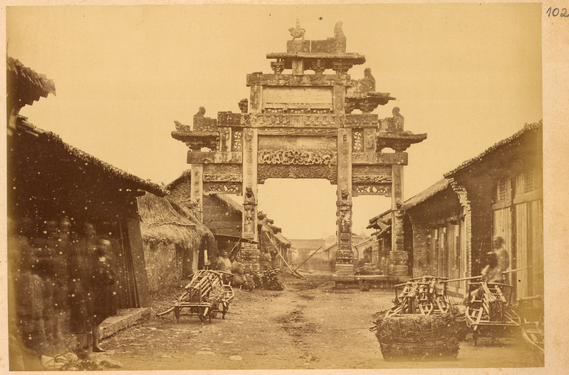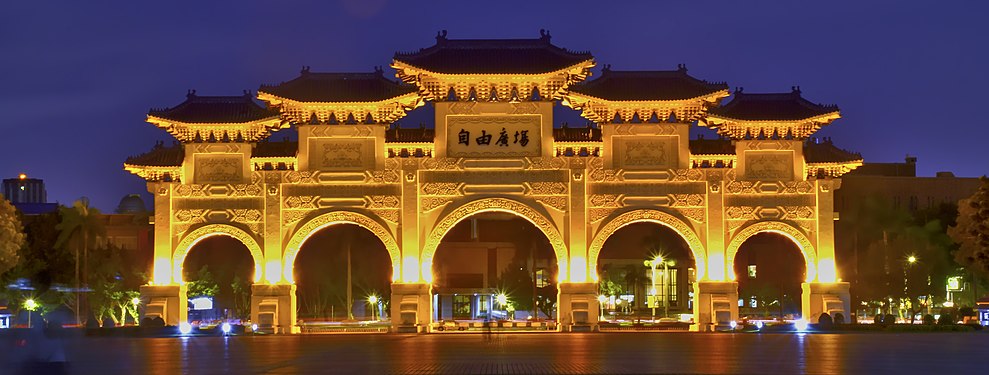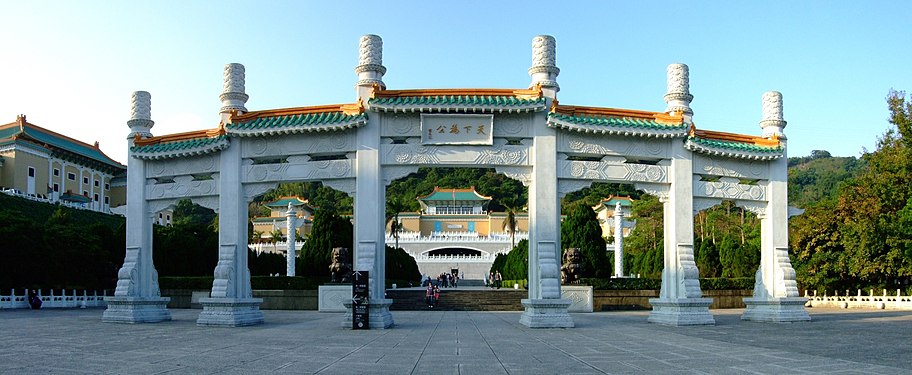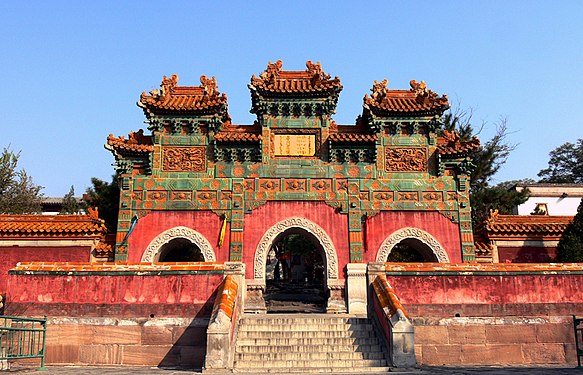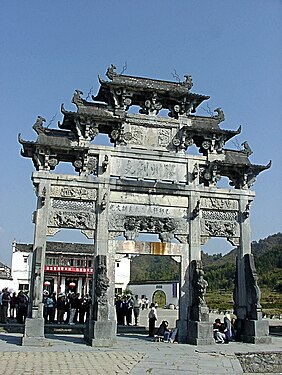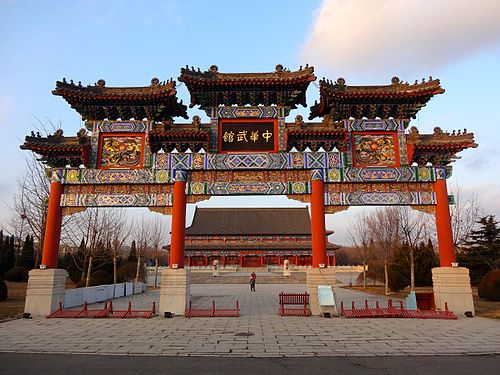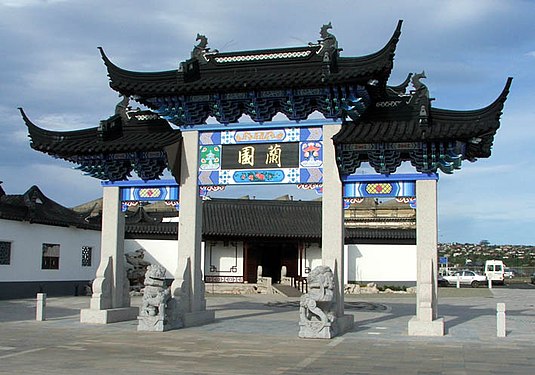Paifang
| Paifang | ||
|---|---|---|
Hanyu Pinyin páilóu | | |
| Bopomofo | ㄆㄞˊ ㄌㄡˊ | |
| Wu | ||
| Romanization | ba平 leu平 | |
| Hakka | ||
| Romanization | pai2 leu2 | |
| Yue: Cantonese | ||
| Jyutping | paai4 lau4 | |
| Southern Min | ||
| Hokkien POJ | pâi-lâu | |

A paifang, also known as a pailou, is a traditional style of Chinese architecture, often used in arch or gateway structures.
Etymology
The word paifang (Chinese: 牌坊; pinyin: páifāng) was originally a collective term for the top two levels of administrative division and subdivisions of ancient Chinese cities. The largest division within a city in ancient China was a fang (坊; fāng), equivalent to a current day ward.[1] Each fang was enclosed by walls or fences, and the gates of these enclosures were shut and guarded every night. Each fang was further divided into several pai (牌; pái; 'placard'), which is equivalent to a current day (unincorporated) community. Each pai, in turn, contained an area including several hutongs (alleyways).
This system of urban administrative division and subdivision reached an elaborate level during the Tang dynasty, and continued in the following dynasties. For example, during the Ming dynasty, Beijing was divided into a total of 36 fangs. Originally, the word paifang referred to the gate of a fang and the marker for an entrance of a building complex or a town; but by the Song dynasty, a paifang had evolved into a purely decorative monument.
History
During the Tang dynasty, it was called a wutoumen (烏頭門; wūtóumén; 'black top gate'), because the top of the two posts were painted black. A wutoumen was reserved for officials of rank 6 or higher.
The construction of wutomen was standardized in the Yingzao Fashi of the mid Song dynasty.[2] It consisted of two posts and a horizontal beam forming a frame and two doors. By the Ming and Qing dynasties, it was called a pailou or paifang, and evolved into a more elaborate structure with more posts and gates, with a superstructural gable on top; the highest rank was a five gate-six post-eleven gable pailou.
It has been theorized that the paifang gate architecture was influenced by Buddhist torana temple gates.[3][4] Paifang have traditional Chinese architectural characteristics such as multi-tiered roofs, various supporting posts, and archway-shapes of traditional gates and towers.[5][6]
Style
Paifang come in a number of forms. One form involves placing wooden pillars onto stone bases, which are bound together with wooden beams. This type of paifang is always beautifully decorated, with the pillars usually painted in red, the beams decorated with intricate designs and
Outside of
In the past, "Chastity Paifang" were given to widows who remained unmarried till death, praising what was seen as loyalty to their deceased husbands.[citation needed]
Gallery
Chinese paifang
-
Ornamental gateway (pailou) from theShaanxi Province, China (1875).
-
A paifang photographed inGansu Province(1933).
-
Paifang of Wuhan University (1920).
-
Paifang at the Cemetery of Confucius, tomb of Lady Yu, wife of Kong Xianpei (72nd generation) in Qufu, China.
-
Paifang in the Chiang Kai-Shek Memorial Square (now Liberty Square) in Taipei. Looking east.
-
Paifang at Liberty Square, in Taipei. Looking west.
-
Decorated paifang at the Summer Palace in Beijing.
-
Colour glaze gateway at Puotuo Zongcheng temple, Chengde.
-
Paifang in Xidi.
-
Pailou at the entrance to Qiandao Lake Scenic Area.
-
Paifangs at the entrance to Yonghe Temple, Beijing.
-
Pailou at the China Martial Arts Hall, Jinshitan, Dalian.
-
Paifang at the entrance to Chinatown in Boston, Massachusetts.
-
Chinatown of Washington, D.C.
-
Pailou at Dunedin Chinese Garden, New Zealand.
See also
- Chinatown gate
- Shanmen, gate of Chinese Buddhist temple
- Hongsalmun, in Korean architecture with both religious and other usage
- Iljumun, portal in Korean Buddhist temple architecture
- Tam quan, a Vietnamese Buddhist style of traditional gateway
- Trụ biểu, in Vietnamese temple architecture
- Torana, a Hindu-Buddhist ceremonial arched gateway
- Torii, in Japanese Shinto shrine architecture
References
- ISBN 9780691191973.
- ^ Li Jie. "The Construction of Wutoumen". Yingzao Fashi 營造法式. Vol. 6: Minor Woodwork I.
- ISBN 978-81-206-0160-4.
- ^ Joseph Needham, Science and Civilization in China, Vol 4 part 3, p137-138
- ISBN 0-8248-2214-5.
- ISBN 978-0-470-52658-3.
- ^ "Friendship Archway, (sculpture)". Smithsonian Institution Research Information System. Retrieved 18 February 2011.
- ^ "Liverpool's Chinese arch ten years standing". BBC. 19 February 2010. Retrieved 18 February 2011.
- ^ Allen-Kim, Erica (Spring 2013). "The Political Economy of Chinatown Gates". Pidgin. No. 15. Princeton University School of Architecture. Retrieved 29 April 2020.
- ^ Exploring Chinatown: Past and Present (PDF) (Report). Los Angeles Conservancy. Retrieved 29 April 2020.
- ^ Historic-Cultural Monument (HCM) List (PDF) (Report). Department of City Planning, City of Los Angeles. April 21, 2020. Retrieved 29 April 2020.
- ^ "Ottawa's Chinatown Celebrates Completion of New Gateway". Government of Canada. October 7, 2010. Retrieved May 21, 2022.
Construction of the arch included a team of technicians from China, as well as a group of artists who used traditional Chinese painting techniques to enhance the many ornate elements of the design. Glazed golden tiles, donated by China, adorn the nine roofs of the structure.
External links
 Media related to Paifang at Wikimedia Commons
Media related to Paifang at Wikimedia Commons

